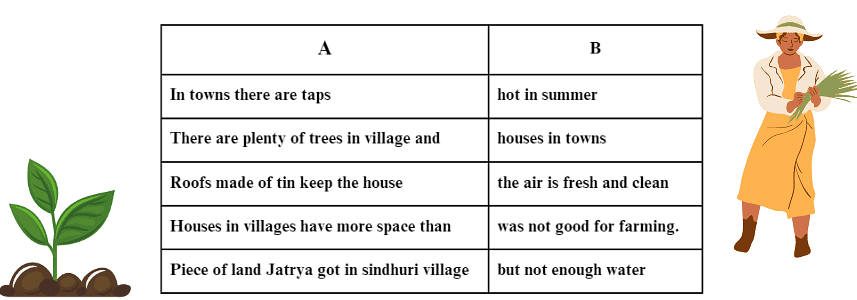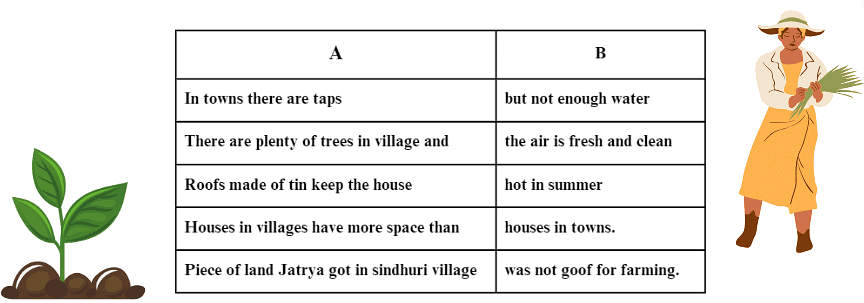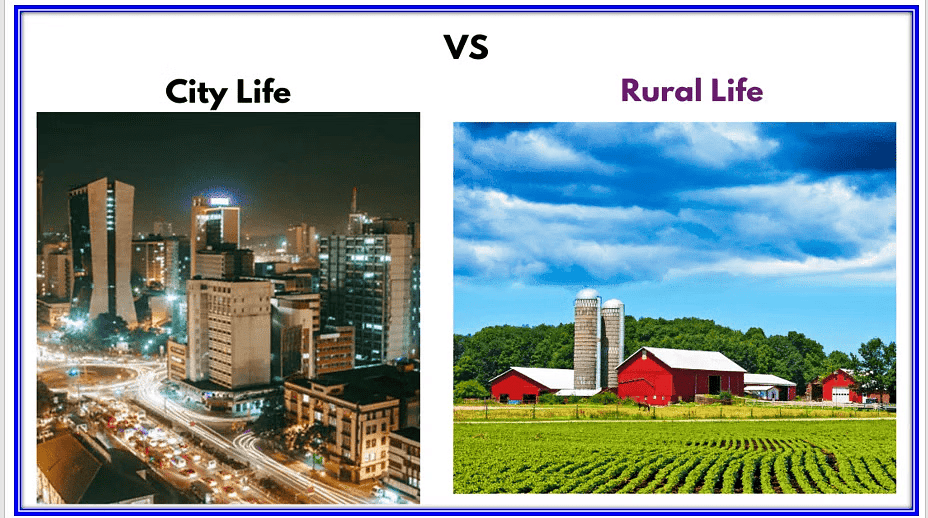No Place for Us Class 5 Worksheet EVS Chapter 18
| Table of contents |

|
| Match the Column |

|
| Fill in the Blanks |

|
| True & False Questions |

|
| Choose the Correct Option |

|
| Answer the following Questions |

|
| True-Life Application Based Questions |

|
Match the Column

Ans:
Fill in the Blanks
(i) __________ is the main occupation of villagers.
(ii) Working with __________, children in the village, one can learn many things.
(iii) A big wall built across the river is called a __________.
(iv) The smoke and smell coming from burning __________ is horrible and unhealthy.
(v) Jatrya’s family moved to __________ village from Khedi village.
(vi) In search of a better life Jatrya’s family moved from Sinduri village to __________ city.
Ans:
(i) Farming is the main occupation of villagers.
 View Answer
View AnswerIn most villages, people primarily engage in farming as their source of income and livelihood. They grow crops and raise livestock.
(ii) Working with elders, children in the village can learn many things.
 View Answer
View AnswerChildren in villages learn practical skills and traditions by observing and helping their elders, such as farming, cooking, and community work.
(iii) A big wall built across a river is called a dam.
 View Answer
View AnswerDams are large structures built to control water flow and store water, often used for generating electricity or irrigation.
(iv) The smoke and smell coming from burning tyres is horrible and unhealthy.
 View Answer
View AnswerBurning tyres release toxic fumes, contributing to air pollution and causing health problems for people living nearby.
(v) Jatrya’s family moved to Sinduri village from Khedi village.
 View Answer
View AnswerJatrya’s family was displaced due to the construction of a dam in Khedi, forcing them to move to Sinduri village.
(vi) In search of a better life, Jatrya’s family moved from Sinduri village to Mumbai city.
 View Answer
View AnswerUnable to adjust to life in Sinduri and facing hardships, Jatrya’s family moved to Mumbai in hopes of finding better opportunities and living conditions.
 Farming
Farming
True & False Questions
(i) In towns there are taps but not enough water.
(ii) In towns people fall sick unlike in villages.
(iii) Children from villages are welcomed in schools.
(iv) Houses in towns have more space than houses in villages.
(v) There are plenty of trees in towns and the air is fresh and clean.
(vi) Roofs made of tin keep the houses cool in summer.
Ans:
(i) True
 View Answer
View AnswerIn towns, even though there are taps, water scarcity is often an issue. Many urban areas face water shortages despite having the infrastructure to supply water.
(ii) True
 View Answer
View AnswerPeople in towns can fall sick due to various factors such as pollution, overcrowding, and lack of clean water, which are often not as prevalent in villages.
(iii) False
 View Answer
View AnswerChildren from villages are sometimes not welcomed in city schools due to differences in social status, appearance, or education levels, making it difficult for them to adjust.
(iv) False
 View Answer
View AnswerHouses in towns typically have less space compared to houses in villages. Urban homes are often smaller due to the high population density, while village homes usually have larger yards and open spaces.
(v) False
 View Answer
View AnswerTowns generally have fewer trees and more pollution, leading to poor air quality compared to villages, where the air is fresher and cleaner due to the presence of more greenery.
(vi) False
 View Answer
View AnswerRoofs made of tin tend to make houses hotter in the summer, as they absorb heat. This makes them less effective for cooling homes during hot weather.
 A House in Village
A House in Village
Choose the Correct Option
(i) Tick the profession adopted by Jatrya Bhai in Mumbai.
(a) Gold Smith
(b) Labourer
(c) Repair Fish Nets
(d) Sweeper
Ans: Repair Fish Nets
 View Answer
View AnswerAfter Jatrya moved to Mumbai, he had to find work to sustain himself and his family. He took up the profession of repairing fish nets to earn a livelihood in the city, which is a common job in coastal areas.
(ii) What do we call Kabaddiwalla in English?
(a) Fruit Seller
(b) Junk Seller
(c) Kulfi Seller
(d) Papad Seller
Ans: Junk Seller
 View Answer
View AnswerA "Kabaddiwalla" is someone who collects and sells old or discarded items, usually metal, plastic, or paper. In English, such a person is referred to as a "junk seller," as their job involves buying and selling items considered junk.
(iii) Which village Jatrya Bhai belonged to?
(a) Sinduri
(b) Dhalpur
(c) Khedi
(d) Sundri
Ans: Khedi
 View Answer
View AnswerJatrya Bhai belonged to the village of Khedi. This is where he and his family lived before being displaced due to the construction of a dam, which led to the village being submerged under water.
(iv) Which musical instrument was not learnt by the children of khedi village?
(a) Dhol
(b) Flute
(c) Guitar
Ans: Guitar
 View Answer
View AnswerThe children of Khedi village learned to play traditional musical instruments such as the dhol and the flute, which are commonly used in local festivals and celebrations. However, the guitar is a Western instrument and was not part of their learning.
(v) Which village Jatrya shifted to after leaving Khedi village?
(a) Khedi
(b) Sundri
(c) Sinduri
(d) Dhalpur
Ans: Sinduri
 View Answer
View AnswerAfter leaving Khedi village due to displacement, Jatrya and his family shifted to Sinduri village. This move was a consequence of losing their ancestral land to the dam project.
 Junk Seller
Junk Seller
 |
Download the notes
Worksheet Solutions: No Place for Us
|
Download as PDF |
Answer the following Questions
(i) How is life in the village different from that of cities?
Ans:
Life in the Village vs. Life in the City
1. Environment:
- Village: Villages are surrounded by nature, with lots of trees, fields, and fresh air. You can see animals like cows, goats, and birds easily.
- City: Cities are full of buildings, roads, and vehicles. There are fewer trees and more noise from cars and buses.
2. Lifestyle:
- Village: People in villages usually live a slower pace of life. They often grow their own food and are very connected to nature.
- City: Life in cities is fast-paced and busy. People often work in offices, shops, or factories and may rely on stores for food.
3. Community:
- Village: Villagers often know each other well and help one another. There are close friendships and a strong sense of community.
- City: In cities, there are many people, so it’s harder to know everyone. People might feel more alone and less connected.
4. Opportunities:
- Village: Job opportunities may be limited, with many people working in farming or local trades.
- City: Cities have more job options, with many different kinds of work available, from technology to entertainment.
5. Facilities:
- Village: Villages may have fewer schools, hospitals, and shops. People may have to travel to nearby towns for certain services.
- City: Cities usually have more schools, hospitals, parks, and shopping centers, making it easier to find what you need.
In summary, life in the village is peaceful and close to nature, while life in the city is fast and filled with opportunities but can feel crowded and busy.
(ii) How does the building of dams affect the life of the people living in that area?
Ans:
The construction of dams can create significant challenges for the local residents, including:
Dam
- Destruction of Homes and Livelihoods: Many people lose their houses and farmland due to flooding or land acquisition for the dam, disrupting their way of life.
- Compensation Issues: Although the government often promises compensation, residents may struggle to receive it on time or in full, leading to financial hardships.
- Quality of Resettlement: While new houses may be provided, they often do not meet expectations. Residents might have limited electricity, with power available only for a few hours, and taps that do not supply water.
- Social Stigma: Local villagers may face discrimination, being viewed as poor and uneducated by others in the area.
- Economic Pressures: Many poor residents collect discarded rubber pieces and old tires, which they sell to rubber industries, as they seek alternative means of income amid these disruptions.
(iii) Why do the poor people in towns collect rubber pieces and old tires?
Ans:
The poor people in towns often collect rubber pieces and old tires due to the following reasons:
- Forced Relocation: After being displaced from their homes, which they had lived in for generations, they lose their established sources of income and security.
- Challenges in Starting A new: Finding new jobs is difficult, and it takes time for children to adjust to different neighborhoods and schools.
- Struggles with Social Integration: Adapting to a new community can be hard, and the transition involves overcoming various social and economic obstacles.
(iv) How did Jatrya suffer in Sinduri? (Write any two points)
Ans:
Jatrya faced several hardships in Sinduri village, including:
- High Living Costs: He had to pay for essentials like medicines, food, vegetables, firewood, kerosene, and fodder for animals, which strained his finances.
- Poor Living Conditions: His house, made of tin sheets, became uncomfortably hot, electricity was available only for limited hours, and there was often no water from the taps. Additionally, the land was not suitable for farming, making it hard to sustain his family.
(v) List the differences between the life Jatrya used to lead in Khedi village and the life in Mumbai? (Write any two differences)
Ans:
Here are two differences between the life Jatrya used to lead in Khedi village and life in Mumbai:
1. Lifestyle and Activities:
Khedi Village: Jatrya's life in Khedi was peaceful, surrounded by nature. He engaged in farming and foraging with his community, enjoying traditions and festivals filled with music and dance.
Mumbai: In Mumbai, life became fast-paced and challenging. Jatrya struggled to earn enough money repairing fishing nets, while his son, Sidya, worked in a fish factory and took on odd jobs just to help the family.
2. Community and Social Life:
Khedi Village: The villagers in Khedi shared close relationships and supported each other through good and bad times, creating a strong sense of community.
Mumbai: In contrast, Mumbai's vast population made Jatrya feel isolated. He only knew a distant relative, making it hard to build connections in the crowded city.
(vi) Why did Jatrya and his family leave Sinduri and migrate to Mumbai?
Ans:
Jatrya and his family decided to leave Sinduri and migrate to Mumbai because they struggled to adapt to their new village. They believed that moving to Mumbai would offer them the opportunity for a better life and a brighter future.
True-Life Application Based Questions
(i) How does moving from rural areas to urban centers affect family dynamics and relationships?
Ans: Moving from rural areas to urban centers can significantly strain family dynamics and relationships, as illustrated by Jatrya's family. In rural areas, families often live in close-knit communities with extended family and neighbors playing an integral part in everyday life. In contrast, urban centers can feel isolating, with individuals often engaging in more individualistic lifestyles. Jatrya's family experiences this when they move to Mumbai, finding themselves without the familiar support network, which affects their cohesion and emotional support.
(ii) What challenges do families face in accessing basic necessities when they move to cities?
Ans: Families moving to cities often face significant challenges in accessing basic necessities. For example, Jatrya's family had to deal with the high cost of living in Mumbai, including paying for water, food, and housing. Unlike their village, where natural resources and community support mitigated survival challenges, the city demands financial resources they might not have, impacting their quality of life and stability.
(iii) Discuss the impact of development projects like dams on local communities.
Ans: Development projects like dams often displace local communities, leading to loss of ancestral land, disruption of community life, and cultural dislocation. In the story, Jatrya's village is submerged underwater due to dam construction, forcing the villagers to relocate and start anew in unfamiliar environments. This not only physically displaces them but also erodes their cultural practices and social structures, which were deeply connected to their original environment.
(iv) How can schools and communities be more inclusive to children from diverse backgrounds?
Ans: Schools and communities can be more inclusive by implementing language support programs, cultural sensitivity training, and inclusive curriculum that reflects the diverse histories and cultures of all students. In Jatrya’s case, his children faced difficulties due to language barriers and cultural differences, which could be mitigated by such supportive educational practices.
(v) What role do government and society play in supporting displaced families?
Ans: Governments and societies have a crucial role in providing adequate support and resources to displaced families to help them integrate into new environments. This includes ensuring access to affordable housing, healthcare, education, and employment opportunities. In the story, the government's promises of improved living conditions were not fully realized, reflecting the need for more accountable and effective support systems.
(vi) How can urban planners and policymakers better accommodate the influx of people in cities?
Ans: Urban planners and policymakers can better accommodate new urban residents by designing inclusive cities that offer affordable housing, efficient public transport, accessible public services, and opportunities for economic participation. Planning should also consider the preservation of green spaces and public amenities that enhance the quality of urban life.
(vii) In what ways can individuals and communities help integrate newcomers into their neighborhoods?
Ans: Individuals and communities can help integrate newcomers by organizing welcome groups, community events, and social gatherings that encourage interactions and friendships. They can also offer language assistance, share information about local resources, and support the newcomers in navigating the new environment effectively.
|
38 videos|242 docs|41 tests
|
FAQs on No Place for Us Class 5 Worksheet EVS Chapter 18
| 1. What is the main theme of "No Place for Us"? |  |
| 2. Who are the primary characters in "No Place for Us"? |  |
| 3. How does the setting influence the plot in "No Place for Us"? |  |
| 4. What are the key conflicts presented in "No Place for Us"? |  |
| 5. What lessons can readers learn from "No Place for Us"? |  |





























